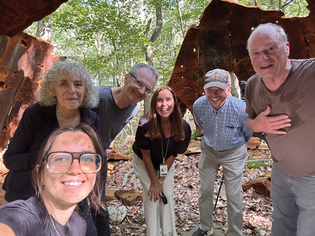
Sophia Pallwein-Prettner
It was a 45-minute hike to YAM’s foam house photo shoot in early September. Art director Jeanine Dunn brought the bug spray. Left to right: photo assistant Sophia Pallwein-Prettner; Dunn; photographer Chris Buck; editor Pippa Jack; executive editor Mark Branch ’86; architect and foam visionary Turner Brooks ’65, ’70MArch.
View full image
My father, a New Zealander whose trip to England on a Rhodes Scholarship was delayed by a crew mutiny in the South Pacific, found his first years at Oxford difficult. His college put all international students in the same dorm, far from their cliquey English counterparts, who made it clear they were not interested in spending time with the foreigners.
Luckily my dad’s roommate, who came from India, was a fantastic cook and the pair passed a pleasant year figuring out how to replicate Punjabi dishes using English substitutions. I made one of their recipes last week, and it reminded me of their stories and the students who made them feel unwelcome. Those students may have been at Oxford to learn, but they had no interest in talking across differences.
American college campuses tend to be less sprawling than Oxford, my hometown and alma mater. That’s a good thing. At the US universities I know best, students and professors run into each other by chance. They collaborate in classrooms, sure, but also in dining halls, walkways, and coffee shops. They make plans, they solve problems, they dream up novel approaches. They have fun. And in the process, they set the global standard for technological, creative, and scholarly innovation.
All of us alumni magazine editors know how fortunate we are. We spend our days immersed in interesting stories that touch every part of our world. We get to regularly call up people who are smarter than us, people who hold positions of power and influence, and ask them lots of questions. And we get to spend our days on college campuses, with their energy, their bookstores, their golden buildings and vivid lawns filled with young people and purpose. From the excitement of fall through the shimmering emptiness of high summer, a feeling persists: that we are all on the cusp of something; that more is possible than we knew. As I’ve walked around New Haven this September, I’ve never felt it more strongly. It’s the storied history—including the honorary degree Yale awarded Mark Twain despite the Corporation’s disagreement with his political views. (See page 37.) It’s the culture of courteous conversation, the commitments to freedom of speech, academic excellence, and service. It’s the daily serendipities an urban campus can create. It’s the sense—as President Maurie McInnis ’96PhD said in her inaugural remarks—that Yale does not yield to the winds of change, but leads them.
Oxford’s 43 colleges are scattered through the city, and when I attended, silos were rigid; classes, as well as room and board, were organized by college. Yale students have a home base, too, but they attend classes with people from across the institution. Most importantly, in traditions from the Yale Political Union to the Cultivating Conversations program, students are encouraged to talk across differences.
It makes me hopeful. I think of the charge McInnis gave to the Class of 2025 at Commencement: “To live what has been learned. To mend what has been broken. To lift up where others have torn down.”
I’ve been exploring (above). I’ve been talking to anybody I can—and it turns out that’s a lot of people, because everyone seems as excited about the magazine’s future as I am. And I’ve been wondering about you. What do you enjoy about the magazine? What would you like to see more (or less) of? What have we never done that we should? I suspect you have thoughts, and here at YAM, we’d like to hear them. A cohort of emerging leaders from around Yale is helping develop a survey to that end, launching next year. In the meantime, please feel free to write to [email protected], for publication or just to talk. I can’t imagine a more exciting project than getting to know YAM’s readers—that immense family of alumni, students, faculty, and staff that extends from New Haven around the globe. I promise these pages will continue to reflect that community—your community—as it helps lead the world, in ways big and small, toward a future in which we learn to talk across differences, mend what’s broken, and demonstrate that more is possible than we knew.
 loading
loading